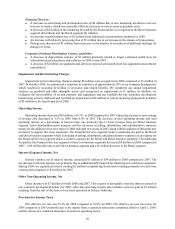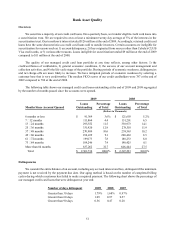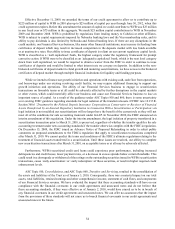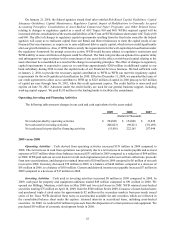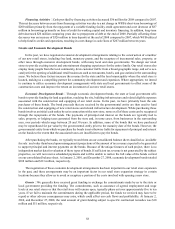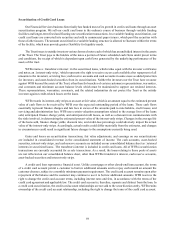Cabela's 2009 Annual Report Download - page 63
Download and view the complete annual report
Please find page 63 of the 2009 Cabela's annual report below. You can navigate through the pages in the report by either clicking on the pages listed below, or by using the keyword search tool below to find specific information within the annual report.54
Effective December 11, 2009, we amended the terms of our credit agreement to allow us to contribute up to
$225 million of capital to WFB in 2010 plus up to $25 million of capital per year through June 30, 2012, when this
credit agreement expires. Before this amendment the amount of capital we could contribute to WFB was $25 million
in any fiscal year or $75 million in the aggregate. We made $25 million capital contributions to WFB in November
2009 and December 2008. WFB is prohibited by regulations from lending money to Cabela’s or other affiliates.
WFB is subject to capital requirements imposed by Nebraska banking laws and the Visa membership rules, and its
ability to pay dividends is also limited by Nebraska and Federal banking laws. If there are any disruptions in the
credit markets, our Financial Services business, like many other financial institutions, may increase its funding from
certificates of deposit which may result in increased competition in the deposits market with less funds available
or at unattractive rates. Our ability to issue certificates of deposit is reliant on our current regulatory capital levels.
WFB is classified as a “well capitalized” bank, the highest category under the regulatory framework for prompt
corrective action. If WFB were to be classified as an “adequately capitalized” bank, which is the next level category
down from well capitalized, we would be required to obtain a waiver from the FDIC in order to continue to issue
certificates of deposits and would be limited to what interest rate we can pay on deposits. In addition to the non-
brokered certificates of deposit market to fund growth and maturing securitizations, we have access to the brokered
certificates of deposit market through multiple financial institutions for liquidity and funding purposes.
While we intend to finance our growth initiatives and operations with existing cash, cash flow from operations,
and borrowings under our existing revolving credit facility, we may require additional financing to support our
growth initiatives and operations. The ability of our Financial Services business to engage in securitization
transactions on favorable terms or at all could be adversely affected by further disruptions in the capital markets
or other events, which could materially affect our business and cause our Financial Services business to lose an
important source of capital. As a result of the guidance under ASC Topics 810 and 860, there is some uncertainty
over existing FDIC guidance regarding standards for legal isolation of the transferred assets. If FDIC rule 12 C.F.R.
Section 360.6 “Treatment by the Federal Deposit Insurance Corporation as Conservator or Receiver of Financial
Assets Transferred by an Insured Depository Institution in Connection With a Securitization or Participation” on
legal isolation is not modified our securitizations will no longer have the benefit of the current rule as they will not
meet all of the conditions for sale accounting treatment under GAAP. In November 2009, the FDIC announced an
interim amendment of this regulation. Under the interim amendment, the legal isolation of property transferred in a
securitization transaction prior to March 31, 2010, is preserved, regardless of whether the transfer qualifies for sale
accounting treatment under new accounting standards if the transfer otherwise complies with the FDIC’s regulation.
On December 15, 2009, the FDIC issued an Advance Notice of Proposed Rulemaking in order to solicit public
comments on proposed amendments to the FDIC’s regulation that apply to securitization transactions completed
after March 31, 2010. We cannot predict the terms and conditions of the FDIC’s ultimate regulation relating to the
treatment of financial assets transferred in a securitization. Until these issues are resolved, our ability to complete
new securitization transactions after March 31, 2010, on acceptable terms or at all may be adversely affected.
Furthermore, WFB’s securitized credit card loans could experience poor performance, including increased
delinquencies and credit losses, lower payment rates, or a decrease in excess spreads below certain thresholds. This
could result in a downgrade or withdrawal of the ratings on the outstanding securities issued in WFB’s securitization
transactions, cause “early amortization” or “early redemption” of these securities, or result in higher required credit
enhancement levels.
ASC Topic 810, Consolidations, and ASC Topic 860, Transfers and Servicing, resulted in the consolidation of
the assets and liabilities of the Trust as of January 3, 2010. Consequently, there was a material impact on our total
assets, total liabilities, retained earnings and other comprehensive income, statement of cash flows, and components
of our Financial Services revenue. We have evaluated the impact that these accounting standards will have on our
compliance with the financial covenants in our credit agreements and unsecured notes and do not believe that
these accounting standards, if they were effective as of January 2, 2010, would have caused us to be in breach of
any financial covenants in our credit agreements and unsecured notes. We can offer no assurances that the impact
from the provisions of these standards will not cause us to breach financial covenants in our credit agreements and
unsecured notes in the future.








